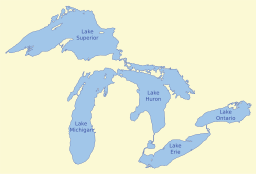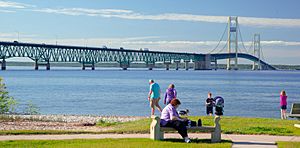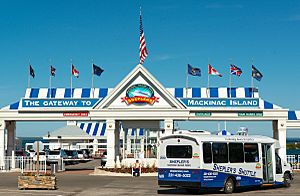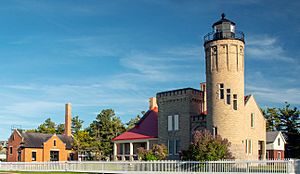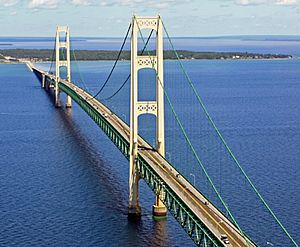Straits of Mackinac facts for kids
Quick facts for kids Straits of Mackinac |
|
|---|---|
|
|
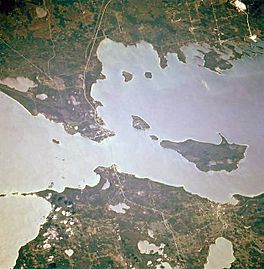
Overhead view of the Straits of Mackinac linking Lakes Michigan (left) and Huron (right)
|
|
| Location | Lake Michigan-Lake Huron |
| Coordinates | 45°48′50″N 84°45′00″W / 45.81389°N 84.75000°W |
| Type | Strait |
| Etymology | Michilimackinac |
| Primary inflows | Lake Michigan |
| Primary outflows | Lake Huron |
| Basin countries | United States |
| Max. depth | 295 ft (90 m) |
The Straits of Mackinac (pronounced MAK-in-aw) are narrow waterways in the U.S. state of Michigan. They are located between Michigan's Lower Peninsula and Upper Peninsula. The main strait flows under the Mackinac Bridge. It connects two of the Great Lakes, Lake Michigan and Lake Huron.
The main strait is about 3.5 miles (5.6 km) wide. Its deepest point is 295 feet (90 meters). Because they are connected, Lake Michigan and Lake Huron can be thought of as one large lake. The local Odawa people called this area Michilimackinac. The currents in the Straits of Mackinac are very strong and unique in the Great Lakes.
Islands in the Straits of Mackinac include Bois Blanc Island and Mackinac Island. Both are populated. Round Island is not inhabited. The Straits are important shipping lanes. They allow raw materials and finished goods to pass through. For example, iron from Minnesota travels to steel mills in Gary, Indiana.
Before railroads reached Chicago from the east, many immigrants came to the Midwest by ship on the Great Lakes. The Straits are 5 miles (8 km) wide at their narrowest point. This is where the Mackinac Bridge crosses them. Before the bridge, car ferries carried vehicles across. Today, only passenger ferries go to Mackinac Island, where cars are not allowed. You can take your vehicle on a car ferry to Bois Blanc Island.
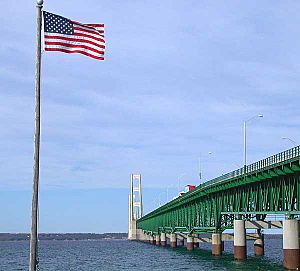
The Straits are shallow and narrow enough to freeze in winter. Icebreaker ships keep the shipping lanes open all year. This allows ships to reach the Lower Great Lakes.
The Straits were a key route for Native Americans and for the fur trade. The Straits of Mackinac are named after Mackinac Island. The local Ojibwe Native Americans thought the island looked like a turtle. So, they named it Mitchimakinak, which means "Big Turtle". When the British arrived, they shortened the name to Mackinac.
On the southern side of the Straits is Mackinaw City. This is where Fort Michilimackinac is located. It is a rebuilt French fort from 1715. On the northern side is St. Ignace. This was a French Catholic mission for Native Americans, started in 1671. The eastern end of the Straits was controlled by Fort Mackinac on Mackinac Island. This was a British and early American military base and fur trade center, founded in 1781.
Contents
History of the Straits
A French Catholic mission for Native Americans was started in St. Ignace in 1671. In 1715, the French built Fort Michilimackinac on the southern side of the narrowest part of the Straits. In 1781, the British replaced Michilimackinac with Fort Mackinac on Mackinac Island.
The Straits Today
A part of the United States Coast Guard patrols the Straits. They are based at Graham Point in St. Ignace. The Coast Guard's Great Lakes icebreaker, USCGC Mackinaw, helps keep a shipping channel clear in winter. This ship is based in Cheboygan, near the eastern edge of the Straits. It started service in the winter of 2005-2006.
Two ferry companies operate from Mackinaw City and St. Ignace. They take tourists and people who live there to Mackinac Island. These companies are Shepler's Ferry and the Star Line Ferry.
Most of the Straits are part of the Straits of Mackinac Shipwreck Preserve. This is a special area set aside by Michigan. It honors the people who were lost on ships that sank in these dangerous waters.
Lighthouses in the Straits of Mackinac include:
- The McGulpin Point Light, located about 3 miles (4.8 km) west of Fort Michilimackinac.
- The Old Mackinac Point Light, in Mackinaw City, which you can visit.
- The Round Island Light on Round Island. You cannot visit this one, but you can see it from the Mackinac Island ferry.
The Enbridge Pipeline
West of the famous Mackinac Bridge is a pipeline called Enbridge Line 5. It was built in 1953. This pipeline is part of a larger system that brings oil from Alberta, Canada, to Lake Superior. The pipeline enters the Straits of Mackinac water near St. Ignace, Michigan. It lies along the bottom of the Straits, which can be nearly 250 feet (76 meters) deep in some places.
By 2013, Enbridge had increased the amount of oil the pipeline could carry to 540,000 barrels per day. When the pipeline was first proposed, its developers said it was "essential to the defense of the United States and the whole North American continent." However, a study by the University of Michigan looked at the risks if the pipeline leaked. This led experts and local governments to ask for the pipeline to be shut down.
In June 2019, the state of Michigan filed a lawsuit. They asked a court to order the shutdown of the part of Line 5 that runs under the Straits of Mackinac. Line 5 is a very important part of Enbridge's network. This network delivers most of Canada's oil exports to the United States. Michigan's lawsuit claims the pipeline is a public problem and breaks the Michigan Environmental Protection Act. This is because it could cause pollution. It is not clear if Line 5 could work without the part that crosses the Straits.
Mackinac Straits Corridor Authority
On December 12, 2018, Michigan Governor Rick Snyder signed a bill. This bill created the Mackinac Straits Corridor Authority. This group is in charge of overseeing the building and operation of a tunnel. This tunnel would hold a new Enbridge Line 5 under the lake bed in the Straits. Governor Snyder also appointed the first members of this authority. They are Geno Alessandrini, Anthony England, and Michael Zimmer. They serve six-year terms.
See also
 In Spanish: Estrechos de Mackinac para niños
In Spanish: Estrechos de Mackinac para niños



